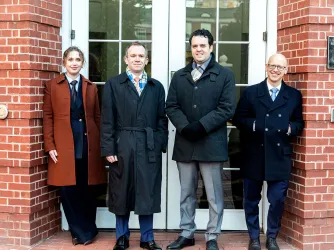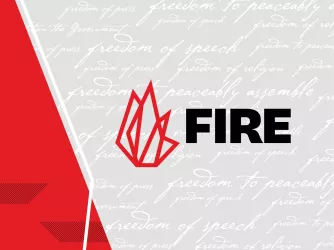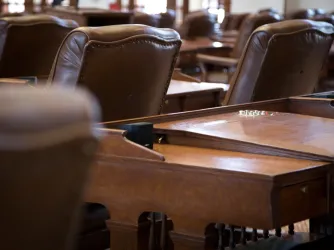Table of Contents
The State of Free Speech on Campus: Swarthmore College

This winter, FIRE is presenting a blog series on the state of free speech at America's top 10 liberal arts colleges, as ranked by U.S. News & World Report. So far, we have covered speech codes at Williams College and at Amherst College. Today, we will discuss speech codes at U.S. News' third-ranked liberal arts college: Swarthmore College.
Swarthmore is the first school in this blog series to receive a "red light" rating, which means that it maintains at least one policy that both clearly and substantially prohibits what would otherwise be protected expression. Although Swarthmore is private, its Student Handbook promises "to ensure that the College does nothing that would tend to diminish free expression or compromise principles of academic freedom in the vigorous and often contentious examination and criticism of ideas, works of art, and political activity that marks Swarthmore College." But the very same Student Handbook contains speech codes that violate that promise.
We turn now to the first of Swarthmore's two red-light policies, the school's Sexual and Discriminatory Harassment Policy and Procedures, which is found on the website of the College's Equal Opportunity Office. The policy starts off well, defining hostile environment sexual harassment as:
[A]ny unwelcome action, verbal expression, usually repeated or persistent, or a series of actions or expressions that have either the intent, or are reasonably perceived as having the effect, of creating an intimidating, hostile, or demeaning educational, employment, or living environment for a student or College employee, either by being sexual in nature or by focusing on a person‘s gender, sexual orientation, gender identity, or gender expression. An intimidating, hostile, or demeaning environment is defined as one that is so severe, pervasive, or objectively offensive that it unreasonably interferes with a person's ability to learn, exist in living conditions, work (if employed by the College), or have access and opportunity to participate in all and any aspect of academic, professional, or residential campus life.
This policy language reasonably tracks the standard for peer harassment set forth by the Supreme Court in Davis v. Monroe County Board of Education, 526 U.S. 629, 651 (1999), which defined peer harassment in the educational context as conduct "so severe, pervasive, and objectively offensive, and that so undermines and detracts from the victims' educational experience, that the victim-students are effectively denied equal access to an institution's resources and opportunities."
If this were where the policy ended, there would be no problem. Unfortunately, the policy goes on to provide that:
Some specific examples of sexual harassment include but are not limited to: unwelcome verbal or physical advances; persistent leers; sexual innuendoes, comments or jokes; the persistent use of irrelevant references or remarks to a person's gender, sexuality or sexual orientation; sexist remarks about the target's clothing or body; expressions using sex stereotypes whether or not they were made about or directed to the grievant and whether or not intended to insult or degrade.... [Emphases added.]
The policy's statement that sexual jokes and "expressions using sex stereotypes" are "specific examples of sexual harassment" contradicts the policy's earlier statement that, to constitute harassment, conduct must be severe, pervasive, and objectively offensive. The example of expressions using sex stereotypes is particularly noxious, because it directly implicates core political speech on gender-related topics, and it states that harassment can occur whether or not the speaker intended his or her speech to "insult or degrade." This is bound to have a severe chilling effect on Swarthmore students' willingness to express controversial opinions on gender-related topics—the kind of chilling effect that undermines Swarthmore's claim to be an institution that values "the vigorous and often contentious examination and criticism of ideas, works of art, and political activity."
Similarly restrictive language can be found in the restatement of this sexual harassment policy located in the College's Student Handbook. According to that formulation, "sexual harassment includes ... the use of sex stereotypes to insult or degrade." The fact that this language—unlike that found in the Equal Opportunity Office's version—requires that the insult be intentional does not save the policy from being overly restrictive. Sometimes people choose to make their opinions known in harsh or insulting ways, but that does not deprive them of the right to express those opinions. To quote the Supreme Court, "Speech is often provocative and challenging. It may strike at prejudices and preconceptions and have profound unsettling effects as it presses for acceptance of an idea. That is why freedom of speech, though not absolute, is nevertheless protected against censorship or punishment, unless shown likely to produce a clear and present danger of a serious substantive evil that rises far above public inconvenience, annoyance, or unrest." Terminiello v. Chicago, 337 U.S. 1, 4 (1949).
In addition to these red-light sexual harassment policies, Swarthmore maintains a yellow-light posting policy (also found in the Student Handbook) that—while much narrower in scope than the sexual harassment policies-also restricts protected expression.
First, the policy requires that "Postings need to be 'signed' with an organization or individual name." But anonymous and pseudonymous speech have an important place in American history, and are of particular importance on a campus whose speech codes almost certainly have a chilling effect on student speech. (For example, if I were a student at Swarthmore taking a position that might be construed as perpetuating gender stereotypes, I would probably want to do so anonymously!)
The policy also provides that "no mention or images of alcohol are allowed." While the college has a right to prohibit posters that advertise the availability of alcohol to minors, this formulation is overly broad. First, many of Swarthmore's students are of legal drinking age, and while the college may promulgate its own regulations with regard to drinking on campus, there is no reason that students 21 and over should not be permitted to organize, for example, a trip to a wine-tasting in the city and invite other students of legal age to join them. Second, the language of this policy is so broad that on its face it prohibits even educational mentions of alcohol on campus postings, such as an advertisement for an Alcoholics Anonymous meeting or a political debate on the appropriate legal drinking age.
Finally, the portion of the policy on "chalking" provides that "demeaning" or "uncivil" expression may be washed away without notice. While the college is under no obligation to permit chalking on its property, it cannot allow chalking but then discriminate against it on the basis of its constitutionally protected content. Most speech that would be considered demeaning or uncivil is nonetheless wholly protected, and if students are allowed, for example, to chalk political opinions on campus, then they must be able to express those opinions in whatever constitutionally protected manner they deem appropriate. (Unprotected expression, such as threats and harassment, would be prohibited.)
The good news is that while Swarthmore maintains several problematic policies, it could still easily earn FIRE's highest, "green light," rating by making a few simple revisions to clarify that protected speech will not be subject to punishment. We hope the college will consider making these changes, and we are always available to help.
Recent Articles
Get the latest free speech news and analysis from FIRE.

VICTORY: Jury finds Tennessee high school student’s suspension for sharing memes violated the First Amendment

DOJ must not investigate elected officials for criticizing immigration enforcement

FIRE statement on calls to ban X in EU, UK
